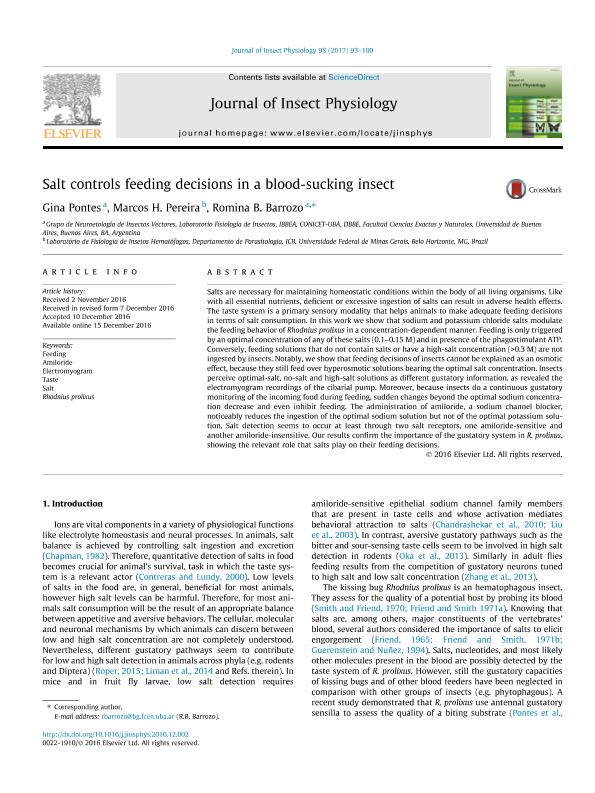Artículo
Salt controls feeding decisions in a blood-sucking insect
Fecha de publicación:
04/2017
Editorial:
Elsevier
Revista:
Journal of Insect Physiology
ISSN:
0022-1910
Idioma:
Inglés
Tipo de recurso:
Artículo publicado
Clasificación temática:
Resumen
Salts are necessary for maintaining homeostatic conditions within the body of all living organisms. Like with all essential nutrients, deficient or excessive ingestion of salts can result in adverse health effects. The taste system is a primary sensory modality that helps animals to make adequate feeding decisions in terms of salt consumption. In this work we show that sodium and potassium chloride salts modulate the feeding behavior of Rhodnius prolixus in a concentration-dependent manner. Feeding is only triggered by an optimal concentration of any of these salts (0.1–0.15 M) and in presence of the phagostimulant ATP. Conversely, feeding solutions that do not contain salts or have a high-salt concentration (>0.3 M) are not ingested by insects. Notably, we show that feeding decisions of insects cannot be explained as an osmotic effect, because they still feed over hyperosmotic solutions bearing the optimal salt concentration. Insects perceive optimal-salt, no-salt and high-salt solutions as different gustatory information, as revealed the electromyogram recordings of the cibarial pump. Moreover, because insects do a continuous gustatory monitoring of the incoming food during feeding, sudden changes beyond the optimal sodium concentration decrease and even inhibit feeding. The administration of amiloride, a sodium channel blocker, noticeably reduces the ingestion of the optimal sodium solution but not of the optimal potassium solution. Salt detection seems to occur at least through two salt receptors, one amiloride-sensitive and another amiloride-insensitive. Our results confirm the importance of the gustatory system in R. prolixus, showing the relevant role that salts play on their feeding decisions.
Palabras clave:
Amiloride
,
Electromyogram
,
Feeding
,
Rhodnius Prolixus
,
Salt
,
Taste
Archivos asociados
Licencia
Identificadores
Colecciones
Articulos(IBBEA)
Articulos de INSTITUTO DE BIODIVERSIDAD Y BIOLOGIA EXPERIMENTAL Y APLICADA
Articulos de INSTITUTO DE BIODIVERSIDAD Y BIOLOGIA EXPERIMENTAL Y APLICADA
Citación
Barcelos Pontes, Gina; Pereira, Marcos H.; Barrozo, Romina; Salt controls feeding decisions in a blood-sucking insect; Elsevier; Journal of Insect Physiology; 98; 4-2017; 93-100
Compartir
Altmétricas




